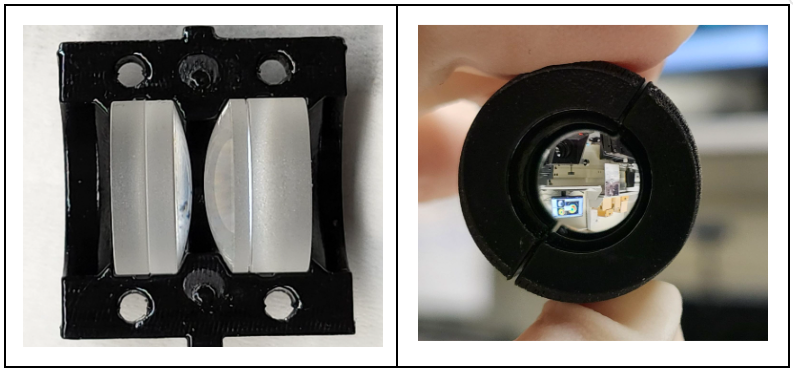Abstract
The 3D printing project aims to design, create, and test a polymer printed part that houses an f/5.6, eight element system. After the system was completed, repeatability measurements were done along with testing our procedure on the similar f/8 system.
Team Members

Customer
Nick Smith – Edmund Optics
Faculty Advisors
Vic Genberg – Department of Mechanical Engineering
Ethan Burnham-Fay – Department of Mechanical Engineering
Vision
Our project was to develop a 3D-printed case for the Edmund Optics’ Ci fixed focal length lens series, initially focusing on the 6mm focal length, f/5.6 system. Subsequently, we replicated the process on the f/8 systems to ensure design repeatability and adaptability to changing tolerances. We established testing procedures, documented our steps for reproducibility, and compared our data with Edmund’s testing results. Our deliverables included a functional prototype, a procedural guide for future projects, and a poster to explain our findings. Our scope excluded lens design or modification, long-term replacement of metal housings, environmental testing, and mechanical evaluation. We aimed to validate the proof of concept for 3D-printed lens housing, and were successful.
Design Description
Prototype Testing on Two Lens System:
In initiating the design phase of this project, we utilized a different, simplified two-lens system from Edmund Optics to assess our prototype designs and ascertain the implications of shrinkage and measurement tolerances for the primary system. We explored numerous design variations, ultimately adopting an interlocking configuration for the two-lens system. Subsequent adjustments facilitated the observation of an image formation when viewing through the system, as depicted in the figure below.

Figure 1: Images of the Two Lens System
After confirming the functionality of the design and verifying its snug fit around the lenses without applying excess pressure, we proceeded to evaluate the system’s performance by conducting measurements of its effective focal length (EFL) and modulation transfer function (MTF), which assesses image quality resolution by analyzing contrast. Initially, we obtained specifications for the component from the Edmund Optics website to establish a reference point for our tests. We subsequently conducted tests using the actual component provided by the company, ensuring that the website specifications and the physical part aligned. Following this verification, we assessed our prototype. Upon confirming that the EFL and MTF closely matched that of the genuine system, we reproduced the printing process to create five additional prototypes of the two-lens system to validate repeatability. Following the evaluation of the EFL and MTF for all prototypes, we compared the aggregated data and observed consistent results with the original Edmund system, including similar effective focal length values.
Figure 2: Plot of all the MTF data for all tested prototypes
| Actual Value | Real Part | 3D Printed AVG | |
| EFL Value (mm) | 9.95 | 9.88 | 9.75 |
| St. Dev. (mm) | N/A | 0.08 | 0.04 |
Table 1: EFL Comparisons
Full f/5.6 Fixed Focal Length System:
Following the promising outcomes with the two-lens system, we initially adopted the same interlocking design methodology for our complete eight-element system. However, upon printing these designs, we discovered that the approach did not provide adequate security for the larger elements, as the three largest lenses in the system fit snugly together with very little movable room to be secured properly.
Figure 3: First Prototype of the f/5.6 System
After thorough exploration of alternative design concepts, it was found that the most secure and optimal fitting approach involved the integration of two distinct design methodologies: the poker chip method and a drop-in assembly specifically designed for accommodating larger lenses at one end. In order to bolster system stability, separate, ring end pieces were engineered to uphold an unimpeded field of view while guaranteeing precise and secure positioning. Following these adjustments, the lenses were seamlessly and securely accommodated within the assembly, facilitating the observation of images through the system.

Figure 4: Images of the Final Design Prototype of the System
Upon confirming the adequacy of lens fitting, the next phase entailed the meticulous evaluation of the MTF for both the authentic component sourced from Edmund Optics and our prototypes. During the MTF assessment, manual control was exercised to ascertain the target’s visibility through the apparatus at various tested angles. The image quality specification from Edmund was an MTF value greater than 0.2 (20% contrast) for all fields at a frequency of 80 line pairs per millimeter. We tested the products from Edmund to verify their performance and then repeated the process on our own parts. As the graphs below demonstrate, specifications were met and far exceeded for all systems, and the printed parts performed consistently with the Edmund ones. This validates the proof of concept that we set out to achieve. Presented below are the MTF profiles, with the orange lines representing those of the real system from Edmund and the blue lines denoting the prototype data.
Figure 5: Plot of the MTF Average for Each f/5.6 System Tested
f/8 System:
Following the successful validation of our prototype’s functionality within the f/5.6 system, our focus shifted towards assessing its adaptability for integration into other components within the Ci series family. To this end, we embarked on modifying the design to align with the specifications of the f/8 system, characterized by a slower aperture. Once more, we procured an authentic component from Edmund Optics to facilitate a comprehensive comparative analysis between our prototypes and the genuine system. Subsequent to conducting the necessary tests, it became evident that the MTF data yielded results strikingly akin to those obtained from the authentic system, further attesting to the efficacy and fidelity of our prototypes. Below is the data from the f/8 real part from Edmund and our printed prototype MTF data.
Figure 6: Plot of the MTF Average for Both f/8 Systems
Conclusions
We constructed a 3D model mirroring the authentic Ci series f/5.6, culminating in results showing that the MTF outcomes significantly surpassed our stipulated criterion of 20% contrast at 80 line pairs per millimeter, while concurrently demonstrating notable comparability amongst themselves. In order to validate these findings, we conducted rigorous assessments of design repeatability within the f/5.6 system, followed by an expansion of our inquiry to assess the adaptability of our design across a broader spectrum of aperture sizes within the same familial lens systems. Subsequent testing of our design within the f/8 system corroborated its remarkable versatility and affirmed its seamless integration across the series, thereby substantiating its efficacy and broad applicability within the familial context.
Acknowledgements
Thank you to Nick Smith, our primary customer contact, for his support, assistance, and encouragement. Thank you also to Jim Alkins, Ethan Burnham-Fay, and Vic Genberg of the mechanical engineering department for their guidance. Lastly, thank you to Wayne Knox for leading our senior design course and helping us along the way.
